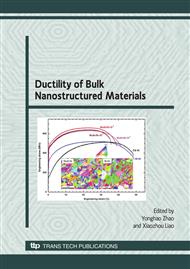[1]
L. F. Mondolfo, Int. Metall. Rev. 153 (1971) 95.
Google Scholar
[2]
I. J. Polmear, Light Alloys, Butterworth-Heinemann, 3rd edn., London (1995).
Google Scholar
[3]
H. Löffler, I. Kovács and J. Lendvai, J. Mater. Sci. 18 (1983) 2215.
Google Scholar
[4]
J. Lendvai, Mater. Sci. Forum 217-222 (1996) 43.
Google Scholar
[5]
G. Sha, A. Cerezo, Acta Mater. 52 (2004) 4503. Figure 7: Stress-elongation curves obtained by tensile testing of the samples shown in Fig. 6.
Google Scholar
[6]
N. Q. Chinh, J. Lendvai, D. H. Ping, K. Hono, J. Alloys Comp. 378 (2004) 52.
Google Scholar
[7]
A. H. Cottrell, Phil. Mag. 44 (1953) 829.
Google Scholar
[8]
A. Van den Beukel, Phys. Stat. Sol. (a) 30 (1975) 197.
Google Scholar
[9]
L. P. Kubin and Y. Estrin, Acta Metall. 38 (1990) 697.
Google Scholar
[10]
P. Hähner, Mater. Sci. Eng. A 207 (1996) 208.
Google Scholar
[11]
D. Wang and Z.Y. Ma, J. All. Comp., in press (2008).
Google Scholar
[12]
C. Xu, M. Furukawa, Z. Horita, T. G. Langdon, Acta Mater. 51 (2003) 6139.
Google Scholar
[13]
Y. H. Zhao, X. Z. Liao, Z. Jin, R. Z. Valiev, Y. T. Zhu, Acta Mater. 52 (2004) 4589.
Google Scholar
[14]
C. Xu, M. Furukawa, Z. Horita, T. G. Langdon, Acta Mater. 53 (2005) 749.
Google Scholar
[15]
J. Gubicza, I. Schiller, N. Q. Chinh, J. Illy, Z. Horita, T. G. Langdon, Mater. Sci. Eng A 460461 (2007) 77.
Google Scholar
[16]
M. Furukawa, Y. Iwahashi, Z. Horita, M. Nemoto, T.G. Langdon, Mater. Sci. Eng. A 257 (1998) 328.
Google Scholar
[17]
L. Balogh, G. Ribárik, T. Ungár, J. Appl. Phys. 100 (2006) 023512.
Google Scholar
[18]
K. Venkateswarlu, M. Ghosh, A.K. Ray, C. Xu, T.G. Langdon, Mater. Sci. Eng. A 485 (2008) 476.
Google Scholar
[19]
N. Q. Chinh, J. Gubicza, T. Czeppe, J. Lendvai, Z. Hegedűs, C. Xu and T. G. Langdon, Mater. Sci. Forum 584-586 (2008) 501.
DOI: 10.4028/www.scientific.net/msf.584-586.501
Google Scholar
[20]
Z. Horita, M. Furukawa, M. Nemoto, A. J. Barnes and T. G. Langdon, Acta Mater. 48 (2000) 3633.
Google Scholar
[21]
Y. Huang, T.G. Langdon, J. Mater. Sci. 37 (2002) 4993.
Google Scholar
[22]
Y. Huang, T.G. Langdon, Mater. Sci. Eng. A 358 (2003) 114.
Google Scholar
[23]
N. Q. Chinh, P. Szommer, Z. Horita, T. G. Langdon, Adv. Mater. 18 (2006) 34.
Google Scholar
[24]
R. Z: Valiev and T. G. Langdon, Prog. Mater. Sci. 51 (2006) 881.
Google Scholar
[25]
N.Q. Chinh, J. Gubicza, T.G. Langdon, J. Mater. Sci. 42 (2007) 1594.
Google Scholar


